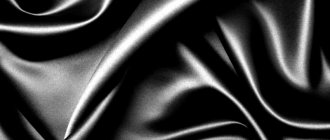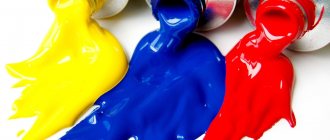The color white began to be studied in psychology relatively recently. Since ancient times, different cultures have attached great importance to flowers, investing each of them with a special meaning. In most cultures, white means purity, innocence, and bright thoughts. The antipode is black - the color of evil, envy and grief.
In the science of psychology, there are many color tests that help determine the state of a person’s psyche. The preferred color of clothing can also tell something about a person's personality. But will such conclusions be 100% correct and accurate? Let's figure out what the color white means in psychology.
Associations with whiteness
Like black, it is a neutral shade. But at the same time it contains purity, innocence, purity, light. When looking at an object with such a color, we are unlikely to experience negative emotions, such as irritation or aggression. On the contrary, it awakens bright feelings in us.
Gamma influences us in such a way that we become imbued with trust in it. After all, on a subconscious level it seems to us that there can hardly be a mystery hidden in it. That's why medical professionals wear this uniform.
This is freedom and self-control, pleasant memories from childhood and adolescence, harmony and bliss. In my thoughts, he will always be a symbol of kindness.
Art
To understand the psychology of the color white, you should familiarize yourself with its influence on some areas of human life and creativity. The interpretation of this paint in fine art is quite interesting. Portraying pure white has always been problematic. And the artists did not want this: against the background of a blank canvas, such a palette would be inappropriate. Therefore, they mixed warm or cool shades and obtained different variations of whitish color. However, in the visual arts this color has always been equated with a divine, majestic influence.
Medieval masters used it when painting pictures and icons with gold and diamonds. The immaculate purity of the Virgin Mary was emphasized by ivory-colored materials. The robes of the clergy also contained white coloring. Emperors and rulers of different countries had outfits of a similar light palette. White color looks surprisingly harmonious both in a solid and elaborate Empire style, and in a gentle, romantic Rococo. It serves as a basis for highlighting other shades. After all, against its background, other colors look brighter.
What does the color white symbolize?
In certain cultures, oddly enough, it means death. When a person dies in the house, women wear headscarves, and men wear clothes in this palette. This is why many people who see snowy tones feel sad: they are associated with a grave.
But why does this happen? Some peoples believe that if the deceased is surrounded by blackness, then in the new world where he must go, he will not be able to see anything. And the light color scheme will show him the direction to the next world.
But such a designation, naturally, is not everyone’s priority. For painters, for example, whiteness indicates endless emptiness and the absence of shade at all. But this is to their advantage, since the colors applied to it are not distorted and retain their saturation. And if you place them on a black background, they will take on a completely different look.
In most cultures, color is a sign of divinity. It is used to denote purity and innocence. And also the right to “start over from scratch.” Let us remember that since ancient times it has meant a truce: when the enemy surrenders, he hangs out a white flag. This action indicates that he is willing to negotiate peace and renegotiate the relationship.
If we look at the night sky, we will see silvery stars. It is impossible to tear yourself away from them, as they attract with their freshness. Therefore, people have associations with hope and the opportunity to receive help from above in difficult life situations.
In many countries, animals and birds with a white color are considered sacred. For example, a cow, Greek horses, a Chinese tiger or an Egyptian bull. We have a widespread tradition associated with pigeons. It is not without reason that snow-white birds are allowed into weddings as a symbol of peace and the beginning of a new and wonderful stage in life.
Significance in psychology
White color is devoid of emotional connotation, so it does not characterize a person’s attitude towards anything, but only determines a person’s energy level. This color is identified with the reaction of flight, release and dissolution.
Most often, white does not provoke anxiety and aggression, but brings peace. A white interior relieves fatigue and relieves nervous tension. However, prolonged stay in a monochromatic white room can lead to apathy, absent-mindedness and depression.
For men
Most representatives of the stronger sex do not have much sympathy for white people. They treat him neutrally. Men are more favorable to cool, muted shades. They also like black color. If a man likes to surround himself with everything white, then this indicates the following traits:
openness, sincerity and honesty sociability aristocracy well-developed imagination love of freedom independence freedom from prejudice romanticism striving for the ideal
Typically, white clothes, white cars or pieces of furniture are chosen by men from the upper class, thereby emphasizing their “chosenness” or “stardom”. However, love for white is more likely not a demonstration, but a desire for a better (beautiful) life, confirmation of one’s status and best qualities.
For women
Unlike men, many women simply adore the dazzling white color. They subconsciously associate it with the bright feminine principle. In everyday life, this color is not at all practical, but the fair sex enjoys surrounding themselves with white interior items and wearing snow-white clothes and linen. Women's strong attraction to this color usually characterizes them as follows:
the girl has unlimited inner freedom, she is very clean and loves order, she thinks positively and is happy to share her good mood with others, sometimes she likes to be alone, she maintains spiritual virginity, she experiences inner peace and serenity
Regardless of a woman’s age and lifestyle, a snow-white wedding dress evokes pleasant and bright emotions in her, because it symbolizes true feminine qualities such as sincerity, kindness, holiness and mercy. Every girl subconsciously wants to meet a new bright stage of her life in such clothes.
For children and teenagers
Children are rarely fascinated by the color white, since babies are usually drawn to everything bright and shiny. Although, on the other hand, every child is like a blank white sheet. Almost all young children love to draw, as if depicting their own world and creating a new life.
White is the color of angelic purity and innocence. A baby's strong interest in white can indicate a powerful spirituality.
If a child leaves a lot of white space on a sheet of paper, this indicates the ability to perceive everything new, as well as resistance to stress. White leaves room for imagination. If a child likes to paint with pearl paints on top of other colors, this indicates great mental potential, openness and friendliness.
Children who love white shades can be described as follows:
freedom-loving, but accommodating and obedient sometimes self-contained confident and sociable disciplined intelligent beyond their years calm and balanced
Teenagers who prefer dazzling white clothes and accessories strive for spiritual purity and perfection. Most likely, they have inflated demands on people and themselves. They pursue ideals and perhaps dream of belonging to bohemia.
White color can calm a hyperactive teenager and switch attention from material to spiritual. Sometimes an addiction to the color white can indicate a loner’s nature, youthful maximalism or inability to adapt to real life.
Properties
This is a neutral shade. When looking at him, no thoughts or emotions appear. He can easily bring an individual to his senses, collect his thoughts and help him calm down.
It can also fill you with energy. If you feel tired or overworked, then it is advisable to rest in a room with a similar spectrum. It will give you slight alienation and harmony.
But you shouldn’t abuse this either, since it also has negative sides. If you look at the whiteness for a long time, a state of loneliness, melancholy and longing sets in.
I do not recommend being in a room where only this range is present. You should mix it with other colors, for example, pastels.
Perception
Features vary. Some perceive paint as a vacuum and meaninglessness, while others surround themselves with a similar palette because they feel purity in it.
Psychologist Daria Milai
Make an appointment
But in everyday life, the tone is absolutely impractical, since stains and dirt are visible on it. This is why many people don't take white things seriously. Before buying clothes, shoes or household items, an individual thinks about how difficult it will be to care for and wash them. From the very beginning this coloring is repulsive.
Many people do not like the color because it evokes associations with mourning. But still, an individual person has his own psychological “foundation”, which depends on many factors. There are those who do not like snowy weather, especially when it has been there for several months. For people living in the northern regions, such a landscape evokes melancholy and apathy, reaching the point of depression.
In other words, monotonous colors can make anyone tired. When there is nothing but whiteness, emptiness is felt. Because of this, the psyche first reacts sharply, and then gradually “falls asleep,” which makes us indifferent to everything that is around.
To prevent this, it is advisable to surround yourself with a varied palette of colors. Even in medical institutions they try to add pictures and make the decoration more colorful. This affects not only the number of visitors, but also the quality of their recovery.
But there is no need to look at it from one side. White color in psychology means joy. When we are surrounded by dark colors for a long time, we involuntarily want to run outside and feel the freedom given by whiteness.
And the following picture emerges: an overabundance of tone makes a person feel uneasy, but the same thing happens because of a lack. Therefore, between the snow-white shade and black there should be intermediate, brighter options. Only then will balance be achieved, and the individual will feel complete psychological peace for a long period.
Psychology of color - symbolism, character, performance
The symbolism of color has a long history. Since time immemorial, people have attached special importance to reading the “language of colors,” which is reflected in ancient myths, folk tales, fairy tales, and various religious and mystical teachings. Thus, in astrology, the rays of the Sun, arranged in a spectrum and giving 7 colors, corresponded to 7 main planets: red - the color of Mars, blue - the color of Venus, yellow - the color of Mercury, green - the color of Saturn, purple - the color of Jupiter, orange - the color of the Sun, purple is the color of the moon. At the same time, the colors symbolized not only the planets and their influence, but also the social status of people, their various psychological states. This was manifested in the selection of clothes of certain colors, folk sayings, rituals, etc. Different peoples have developed a certain symbolism of colors that has survived to this day.
Thus, since ancient times, people have shown a special interest in the color red. In many languages, the same word means the color red and, in general, everything beautiful and beautiful. Among the Polynesians, the word "red" is synonymous with the word "beloved." In China, a sincere, frank person is said to have a “red heart,” while the heart of a bad, treacherous person is black.
Symbolism of flowers
The color red is primarily associated with blood and fire. Its symbolic meanings are very diverse and, at times, contradictory. Red symbolizes joy, beauty, love and fullness of life, and on the other hand - enmity, revenge, war. Since ancient times, the color red has been associated with aggressiveness and sexual desires.
Red is the main heraldic color. On the banner it symbolizes rebellion, revolution, struggle. It is interesting that among many tribes in Africa, America and Australia, warriors, preparing for battle, painted their bodies and faces red. The Carthaginians and Spartans wore red clothing during war. In ancient China, rebels called themselves "red warriors", "red spears", "red eyebrows"..
Red also denotes power and greatness. In Byzantium, only the empress had the right to wear red boots. The emperor signed in purple ink and sat on a purple throne. For many peoples, the color red symbolizes the south, flame and heat.
White color symbolizes purity, spotlessness, innocence, virtue, joy. It is associated with daylight, as well as with the productive force, which is embodied in milk and eggs. Associated with whiteness is the idea of the obvious, the conventional, the legitimate, the true.
In ancient Rome, Vestals wore white dresses and white veils. Since antiquity, the color white has had the meaning of detachment from the worldly, striving for spiritual simplicity. In the Christian tradition, white denotes kinship with the divine light. Angels, saints and righteous people are depicted in white. Among some peoples, kings and priests wore white clothes, which symbolized solemnity and grandeur.
However, white can also have the opposite meaning. By its nature, it seems to absorb, neutralize all other colors and correlates with emptiness, incorporeality, icy silence and, ultimately, with death. The Slavs dressed the dead in white clothes and covered them with a white shroud. It is customary among some tribes in Africa and Australia to paint the body with white paint after the death of someone close to them. In China and some other countries in Asia and Africa, white is the color of mourning. In the old days, white mourning was also used by the Slavs.
Black color, as a rule, symbolizes misfortune, grief, mourning, and death. Thus, in ancient Mexico, during the ritual sacrifice of a person, the face and hands of the priests were painted black. Black eyes are still considered dangerous and envious. Ominous characters are dressed in black, whose appearance portends death.
It is also believed that there is a connection between the color black and sexual attractiveness. Among some African tribes, women with very black skin are highly valued as lovers, but not as wives. Love passion is shrouded in darkness and mystery; therefore, black can symbolize something intimate and passionately desired. Among the Arabs, the expression “blackness of the eyes” means beloved, “blackness of the heart” means love.
Thus, black can also have a favorable meaning. It is perceived this way, for example, in the arid regions of Africa, where there is little water and black clouds promise fertility and abundance. Black bulls, goats or birds are sacrificed to the guardian spirits who send rain, and the priests also dress in black.
Yellow is the color of gold , which since ancient times has been perceived as a frozen solar color. This is the color of autumn, the color of ripe ears and fading leaves, but also the color of illness, death, the other world.
Among many nations, women preferred yellow clothes. Often the color yellow served as a distinctive feature of noble persons and upper classes. For example, Mongolian lamas wear yellow clothes with a red belt.
On the other hand, among some Asian peoples, yellow is the color of mourning, grief, and sadness. In Europe, a yellow or yellow-black flag meant quarantine, and a yellow cross meant plague. Among the Slavic peoples, yellow is considered the color of jealousy and betrayal, and in Tibet jealousy is literally called “yellow eye.” Let us also remember the “yellow press” and the “yellow house”
For many peoples, the color blue symbolizes heaven and eternity. It can also symbolize kindness, fidelity, constancy, favor, and in heraldry it denotes chastity, honesty, good reputation and fidelity. "Blue blood" speaks of noble birth; The English call a true Protestant a “blue.”
In addition, the color blue is close to black and receives similar symbolic meanings. It was considered mourning in Ancient Egypt and among some peoples of South Africa. The French call horror “blue fear” (remember the fairy tale about “blue beard”. Among the Slavic peoples, blue served as the color of sadness, grief, and was associated with the demonic world. Ancient legends describe black and blue demons.
Green is the color of grass and leaves. For many peoples, it symbolizes youth, hope, fun, although sometimes it also symbolizes immaturity and lack of perfection. Green color is extremely material and has a calming effect, but it can also produce a depressing impression (it is no coincidence that melancholy is called “green”, and the person himself “turns green” with anger).
Iranians associate the color green both with rapid growth and freshness, and with misfortune, sadness, sorrow, which is why they say “green leg” about an ill-fated person, and “green house” about a cemetery. In medieval Europe, jesters wore green and yellow clothes, and bankrupts in Germany had to wear green hats.
The ancient symbolism of colors and their interpretation in various cultures is confirmed in modern theories of the relationship between color and emotional-volitional states not only of an individual, but also of entire communities. The correspondence between color and the dominant psychological state was studied by M. Luscher, I. Goethe and other psychologists.
Today, flower symbolism is widely used in business advertising. Psychologists have found that blue, gold, white, black, red are colors that can be used to identify a product with the elite segment, since these are “expensive” colors that have been identified with the elite of society for centuries. Indeed, in goods in the upper price range, the combination of blue or black with gold is very common. Black color allows you to effectively highlight a logo (made, for example, in gold) or an image of the product itself. This is done in order to concentrate the consumer’s attention not on the packaging, but on the product itself, to show its significance and prestige. For example, this technique is used by many producers of expensive alcoholic beverages, in particular Johnny Walker and Black Label whiskey, Comus or Martell cognac. This way the name of the product stands out and emphasizes that this is an elite drink. The same approach is practiced when creating expensive perfumes and colognes for men.
More on the blog: How to get into the flow
If the colors of the premium segment should be associated with confidence and solidity, then the combination of red and yellow, on the contrary, is associated with a feeling of joy, warmth, and fun. It is no coincidence that these two colors are used by the “folk” restaurants McDonald's and Lipton tea. Green and blue, which are considered the colors of May morning, have their own associations. They are usually used to show the freshness of the product.
There are also colors that are strictly forbidden to be combined with each other, as they evoke negative emotions in the consumer. For example, a combination of purple and orange speaks of hopelessness and suicide. The same effect is caused by an inscription written, for example, in white letters on a dull black background.
Color and character
Each person gives preference to one color, at least no more than two or three (depending on where these colors are used - in clothing, furnishings, car color, etc.). The pleasant or unpleasant feeling that a particular color evokes can change over time. But in any case, the color you prefer can tell a lot about your character and emotional makeup. Psychologists in such cases use a color test developed by Swiss psychologist Max Lüscher in the late 1940s. The Luscher test, used by professional psychologists, requires special training for its use. The “lighter” version of the Luscher test can be easily tested by anyone, using the usual settings of a modern color TV.
Psychologists say: if the color red predominates, then the owner of the TV is trusting, but overly emotional and aggressive. If yellow stands out clearly, then such a person inspires confidence in others, is an optimist and expresses friendliness. But the constant smile on his face is most often a mask behind which hides strong internal tension. The predominant blue-green color indicates that the person is timid and weak, but dangerous if someone gets in his way. And finally, those who prefer light blue are accommodating, lazy and do not know moderation in food and drink.
An experienced observer may also be able to provide additional information about a person by their preferred color of car. As proof of this, we can cite data from the American psychologist Berthold Schwartz, who claims that the color of a car can be used to judge some of the psychological characteristics of its owner. Thus, the owners of red and yellow cars are optimists, lovers of life and consider themselves happy. Green ones are worn by nature lovers and realists. Blue is chosen by people with a balanced character. Owners of white cars adhere to conservative views, while business people drive black ones. Gray and silver ones are to the taste of proud people, and brown ones are preferred by respectable spouses and fathers of large families.
Below is a description of the main colors. Based on the preference for one color or another, everyone can independently draw a conclusion about their psychological characteristics.
- white is a synthesis of all colors, which is why it is the “ideal” color. It contains a significant meaning, since it simultaneously conveys the brilliance of light and the coldness of ice. This color can be preferred by a person with any character; it does not repel anyone;
- black is the color of uncertainty, symbolizing a gloomy perception of life. Anyone who prefers to dress in black often perceives life in dark colors, is unconfident, unhappy, and prone to depression, because he has no doubt that his ideals in life are unattainable. Frequently changing a black suit or dress to another, brighter, catchier one, indicates that pessimistic moods often dissipate. The constant choice of black indicates the presence of a certain crisis state and characterizes aggressive rejection of the world or oneself (remember the black banners of anarchists). Children who are acutely experiencing a lack of care and love often use black shading in their drawings. Normally, black is generally rejected;
- gray is the favorite color of sensible and distrustful people who think for a long time before making any decision. It is also a neutral color favored by those who are afraid to make a statement too loudly. If you don’t like this color, then this is an indicator of an impulsive, frivolous character. Often, gray color is also preferable in case of severe overwork as a barrier, fencing off the irritants of the outside world. In situations of psychological testing, this color is used as a means of protection against the penetration of another into the inner world of the subject. A study of about two thousand young men in a situation of competitive examinations for vacant positions showed that the color gray was put in first place by 27% of the examinees instead of the usual 5% in a normal situation;
- red is the color of passions. If this is your favorite color, then such a person is brave, he is a strong-willed, domineering type, quick-tempered and sociable. Moreover, he is an altruist. People who are irritated by this color have an inferiority complex, fear of quarrels, a tendency towards solitude, stability in relationships. The red color symbolizes excitement and energy. This color is also a symbol of eroticism. Disgust and ignoring red reflects organic weakness, physical or mental exhaustion. Prisoners of war, forced to live for years in life-threatening conditions, were especially likely to reject him. Red is the color most preferred by teenagers;
- brown - chosen by those who stand firmly and confidently on their feet. People who have a soft spot for him value traditions and family. The preference for brown reflects, first of all, the desire for simple instinctive experiences, primitive sensual joys. At the same time, the choice of this color as the most preferred also indicates a certain physical exhaustion. Normally, along with black, brown is the color most often rejected;
- yellow - symbolizes calmness, ease in relationships with people, intelligence. Being loved means being sociable, curious, courageous, adaptable, and enjoying the opportunity to please and attract people. When he is unpleasant, then we are talking about a concentrated, pessimistic person with whom it is difficult to establish an acquaintance. Yellow comes from mixing green and red and is the color of energy. The greatest preference for yellow is given to pregnant women expecting a successful outcome of childbirth, as well as people who are prone to changing places. Yellow is also interpreted as the color of illumination (the halo of Christ or Buddha);
- blue is the color of the sky, peace, relaxation. If you like him, then this speaks of modesty and melancholy; such a person often needs to rest, he gets tired quickly, a sense of confidence and the goodwill of others is extremely important to him. The rejection of this color reveals a person who wants to give the impression that he can do anything in the world. But, in essence, he is a model of uncertainty and isolation. Indifference to this color speaks of a certain frivolity in the field of feelings, although hidden under the guise of courtesy. In short, choosing blue as the most preferred color reflects a person's physiological and psychological need for peace, and denying it means that a person avoids relaxation. When ill or overworked, the need for blue increases;
- green is the color of nature, nature, life itself, spring. The one who prefers it is afraid of other people's influence, looking for a way to assert himself, since this is vitally important for him. Anyone who does not love him is afraid of everyday problems, the vicissitudes of fate, in general, all difficulties. The color green contains hidden potential energy and reflects the degree of volitional tension, therefore people who prefer green strive for self-confidence and confidence in general. Eccentric people, who achieve their goals not through targeted volitional activity, but through emotions, reject green as an unattractive color. Along with them, green color is rejected by people who are on the verge of mental and physical exhaustion.
More on the blog: Incredible about a simple thought
Other colors can also tell about the psychological characteristics of a person’s condition. Thus, orange is the favorite color of people with intuition and passionate dreamers. In heraldry, this color also means hypocrisy and pretense. Pink is the color of life, of all living things. He talks about the need to love and be kinder. Those who like him can become agitated over the most insignificant things. For people who are overly pragmatic, this color causes irritation. violet symbolizes the inherent infantility and suggestibility of a person, the need for support and support. In this sense, the choice or denial of the color purple acts as a kind of indicator of mental and sexual maturity.
Research conducted by Russian psychologists V.F. Petrenko and V.V. Kucherenko, confirm the existing relationship between a person’s emotional states and his choice of certain colors as preferred. Thus, in situations of joy and fun, energy-saturated colors (yellow and red) are especially preferred, while the colors of peace and relaxation (blue and brown), as well as the color of non-existence (black), are simultaneously rejected. For situations where a person experiences a feeling of guilt for various actions, it is typical, on the contrary, to reject energy-saturated red and yellow and prefer gray and blue colors. Blue, therefore, reflects not only serene peace and relaxation, but in combination with gray corresponds to a state of passive depression. In situations that pose any danger to a person, there is a preference for green, associated with volitional tension, and yellow as energy-saturated, associated with the need for a quick release of tension. Moreover, if fear is characterized by a predominance of green and gray colors while rejecting yellow, red and violet, then aggressive arousal in response to danger is characterized by a combination of yellow and green while rejecting black and brown.
Color and performance
Currently, scientists are making active attempts to use the influence of color on human psychophysiology for commercial and domestic purposes. Moreover, as already noted, each person perceives color in his own way. Therefore, decorators and designers, when designing the interior of premises, must always take into account socio-demographic characteristics - gender, age, profession, etc. However, there are some general characteristics of the effects of flowers on humans. The predominance of any color (or combination of colors) in the design of a room creates a certain emotional and business environment. Few businessmen know that the color scheme of the interior affects the human subconscious. And not only on the performance of employees, but also on the results of business negotiations.
Thus, blue color promotes better assimilation of information and the establishment of friendly relationships , therefore it is recommended to be used in meeting rooms. And, it would seem, blue, which is close to it, on the contrary, distracts attention and reduces the efficiency of staff. So many managers don’t even realize that the reason for the sharp decline in their company’s commercial profit could well be... a chic European-quality renovation in the office, done in the now very fashionable “sky blue” style.
Green color has a calming effect on the nervous system, relieves headaches, fatigue, irritability, and lowers blood pressure. Red increases the level of adrenaline in the blood, increases performance and is therefore especially recommended for slow, lethargic people. However, an excess of red and green at the subconscious level awakens a thirst for profit in a person, and red, among other things, increases aggressiveness (it is no coincidence that the red jacket became the symbol of the “new Russians”). Purple color improves the functioning of the heart and lungs, increases the body's endurance. Nevertheless, it should not be overused: this color is a subthreshold catalyst for fatigue. So if you want to buy a purple blouse, then it’s time to go on vacation.
The transition in a room from yellow to blue is calming. People walk on a pink floor with caution, while on a brown floor they walk confidently. White luminescent color irritates the nervous system, and yellow-orange light from lamps promotes creative thinking and good mood.
It has also been noted that in public places where color is limited to white, black and gray, people do not linger unless absolutely necessary. Colors can visually expand rooms (for example, yellow and yellow-green) or narrow them (red-orange). At the same time, in a red room it seems 3-4 degrees warmer than in an orange one, and in an orange room it seems 3-4 degrees warmer than in a blue-green room.
Each color carries its own emotional load, which must be taken into account when stimulating work activity.
Thus, the combination of red and blue-green colors stimulates overall performance. Yellow or yellow-green with orange relieves mental fatigue, and yellow alone promotes mental activity. Blue color is recommended in child labor rooms, pink in the welding shop, blue in the lathe. In general, when working, yellow-green tones in various combinations and shades are most optimal. During meals, orange-red tones are preferred, and during rest hours, it is not so much the tone that is important, but the dynamics of the colors.
So what colors are recommended to be preferred when decorating an office?
It is better to use yellow tones, but in small quantities. Large doses of yellow create excessive greed (who needs employees who are always dissatisfied with their salaries or partners who make excessive financial demands?), and small doses stimulate brain activity and increase the efficiency of mental work. Moderate doses of yellow contribute to the success of negotiations, as they stimulate the desire to find compromises.
Source
Read us in a convenient Telegram | Facebook | Instagram | Tags
Application in advertising
The palette means openness. And most often it is used as a background component, since it does not contain a load in the form of emotions and meaning.
Face-to-face consultation
What are the features and advantages of face-to-face consultation?
Find out more
Skype consultation
What are the features and benefits of Skype consultations?
Find out more
If the advertising product does not set itself the task of evoking specific feelings in the audience, then a whitish color is perfect for simply conveying information.
We must not forget that white color is a symbol of purity and purity. It is often found in commercials with children's products or bedding sets. Marketers say that this tone is perfect for making purchases.
History of the method
Humanity has always been aware of the influence that the world around us has on it. Johann Wolfgang von Goethe also argued that all dark colors excite the mind, and dark colors calm the mind. The meaning of white and other colors must be interpreted depending on the area in which the shade is applied. So, a person may have one preference in clothing, but another in interior design.
Despite this, the meaning of white will allow us to draw conclusions about the character of the individual. This theory was put forward many years ago by abstract artists: Wassily Kandinsky, Kazimir Malevich, Piet Mondrian, Johannes Itten. Thanks to their research, they determined that in psychology, white color influences the well-being and physical state of the body systems through subconscious processes. In Ancient Egypt, China and India, healers and shamans, who then acted as psychologists, knew about the influence of white color on the state of the psyche. The well-known Avicenna made his conclusions about a similar phenomenon in his time.
Today's color treatment system has its roots in the developments of the 19th century. A group of American and English scientists led by Edwin Babbitt studied in detail the degree and nature of the influence and meaning of the color white in practical psychology. Today, all specialists in this field use the advanced developments of these specialists.
Impact on health and psyche
- Physiological effects. When we spend a long time in a snow-white room, we feel how fatigue slowly passes, and in its place comes calm, harmony and even euphoria. But this is provided that the palette is diluted with other colors. But when there is a lot of it, irritation occurs, and the eyes begin to hurt: the pupils become narrower, the senses become more acute.
- Psychological. Most often, it does not cause aggression, but carries only positivity. But monotony can provoke a feeling of endless emptiness, which leads to apathy and even depression.
Who likes it
This aspect depends on the person’s temperament and character, because everyone perceives it differently. For some, whiteness is their favorite color. Such individuals are easy-going and very demanding of what surrounds them. They consider themselves bohemians.
Those who prefer a luxurious and carefree life wear such clothes and bask in the rays of the southern sun. And all the objects surrounding them - the ceiling, furniture, dishes, bed linen - are made in the same colors.
But this stereotype is not always true. There are a variety of personalities among amateurs. After all, the symbolism of white color does not carry anything bad.
Anyone who loves this color has the following traits:
- accuracy;
- severity;
- caution;
- pedantry;
- attentiveness.
They often show a not entirely healthy craving for ideal order and cleanliness. They are hostile to spontaneity - they follow specific rules and a set schedule for the day.
These are quite wise and intelligent people. They calculate their steps and carefully weigh any decision. Self-control and patience are their strong point. It is difficult to provoke such individuals into emotions, and they often have high (sometimes even too high) self-esteem.
general characteristics
White color is the fusion of all the colors of the rainbow. Surprisingly, this is true. The fact is perceived by a person rather symbolically. It seems as if the entire material world merges into one point, so we are able to see the color white, which in psychology has many meanings.
Even without scientific research, ancient people elevated him to the rank of a divine principle. To this day, this perception remains relevant. The meaning of white flowers often indicated purity and light. And light is a symbol of divine power, the mind of the individual. In psychology, perhaps, there is no color as symbolic as white. He is everything and nothing. A white surface inherently reflects all rays of light falling on it. Therefore, we see exactly this color of the object. The meaning of white flowers in this plane is very important, since it is interconnected with the characteristics of human perception.
In addition, white is an achromatic color. Its antipode is black paints. Psychologists take this fact into account. After all, the struggle between light and shadow, good and evil is eternal. It should also be noted that the color white is perceived differently by women and men, adults and children. When analyzing a person’s mental state, it is necessary to take into account every nuance in the study.
What does dislike of the color white mean?
In this case, most likely, the person is the absolute opposite of the image described above. Such individuals are less organized and reasonable; they do not strive for absolute purity and control. In company they are characterized by relaxed behavior.
Sometimes they prefer a little chaos. For example, a perfectly tidy desk will irritate them.
Who is it recommended for?
Both in the wardrobe and in interior design, whiteness is perfect for those who love order and neatness. Against such a background, the slightest flaws will be visible, so it will be a good solution for confident people who want to feel more freedom.
The whitish tint visually expands the boundaries. He is adored by those who want to live in balance and peace not only with their own inner world, but also with their outer world.
When there is a need to take a break, relax from the everyday hustle and bustle, and feel calm, it is definitely recommended to add color to the interior or to your appearance.
The main thing is not to focus only on a monochromatic palette. It should be diluted with other colors, since excessive exposure to snow-white walls causes irritation or melancholy.
Negative effects of color
White is the color of success and prosperity, but it is good in reasonable quantities. Its excess can negatively affect work activity and distract attention. Staring at white for too long can create a feeling of emptiness and loneliness. White is a symbol not only of successful and wealthy people, but also of hermitage, sacrifice and death.
It’s not for nothing that polar explorers often feel sad and suffer from depression. A long stay surrounded by white color has a depressing effect on the nervous system. There is such a thing as sensory hunger, which means a lack of emotional sensations. It occurs when a person does not receive the required amount of visual images, as well as sound signals and tactile sensations.
Application in clothing
In all eras, people considered such robes sacred. For example, the priestesses of the temple in honor of the goddess Vesta took vows of innocence and wore outfits exclusively of this tone. The Roman and Egyptian peoples had such a wardrobe and embodied power and inviolability. Therefore, it is inherent in higher positions: priestesses and rulers.
In the Catholic and Orthodox religions, righteous people were depicted in similar robes. Kohler means the rite of baptism and communion (it is still used in these ceremonies).
Color is significant at a wedding. From time immemorial, all brides wear white dresses as a symbol of purity and purity.
Such clothing also has a place in everyday life, since it does not look vulgar and at the same time gives the image solemnity and airiness. It is also preferred for festive occasions, official receptions and events.
Whiteness is present in the uniform of many professionals: in science, medicine, cooking. It inspires confidence and indicates sterility.
Ask a question
What does Feng Shui mean?
This is a sign of perfection and lightness. Its distinctive feature is that it contains the entire spectrum. And in many countries it is associated with divinity.
In this science, it is believed that snow-white cleanses energy. People who prefer it are sincere and truthful. They are neat, but often become too demanding on this basis.
According to the rules, such individuals should not place mirrors in places opposite the bed or doors. In the first case, this can destroy the marriage bond, and in the second, all positive energy will evaporate.
The tone activates imagination and allows you to unleash your creative potential. It also brings to the fore the best that is in the human soul and points the direction towards humility. Many attribute to him the ability to spiritually heal.
It is recommended to use the palette in kitchen design. Against a whitish background, all foods and dishes will look bright, which will lead to an increase in appetite. But if the room is cool, then the presence of whiteness should be minimized, since the cold will be felt even more strongly.
Interior decoration
The psychological meaning of white color varies. Much, as has already been said, depends on its application in different spheres of human life. If in clothing or art there are some associations with it, then when decorating the interior a slightly different picture emerges. Designers use such paints to create the effect of lightness, completeness and volume of the room. This allows you to visually increase the space. This influence is similar to the principle of operation of mirrors.
In the interior, the walls or ceiling can be snow-white. But darker shades are selected for the floor. Most often, the designer uses bleaching of walls and ceilings to create a base on which various stylistic effects will be applied. There are no restrictions here. Almost any style of room decoration can be created on a similar foundation. If we turn to the principles of Feng Shui, we can find out that northwestern rooms, decorated in white, will purify the energy of the people in the house. It will restore activity and give strength for new achievements.
What do white bouquets mean?
Often such flower arrangements are given to brides or young ladies, as they are a symbol of youth and innocence. But this is a generalized opinion. In most cases, the meaning of such a gift depends on the attitude of the donor towards the person to whom he is presenting a snow-white flower.
Often, a bouquet is chosen by gentlemen who know how to care for ladies and who know exactly the value of their chosen one. But at the same time, inflorescences can also mean that a man does not want events to develop quickly, since he wants to get to know his companion gradually.
It is worth paying attention to the variety of plants:
- Roses are a declaration of sincere love. This is the opposite of red, which symbolizes passion.
- Lilies. The personification of femininity and at the same time greatness. Therefore, the bouquet will be an excellent gift for the fair sex, worthy of admiration. It expresses luxury and elegance.
- Chrysanthemums. A sign of a happy and prosperous life. This composition is also suitable for gentlemen, but mature ladies love it most. It is appropriate to present it to mothers or grandmothers.
- Gerber. Flowers radiate cheerfulness and tenderness. They give a great mood and bring a smile to your face. This will be an excellent present for your beloved girl, not only for a celebration, but also for everyday life.
- Eustoma. The embodiment of kindness and friendliness. Such a surprise carries sincere wishes of all the best, and also expresses affection. This variety is not common these days, but the bouquet will look original.











